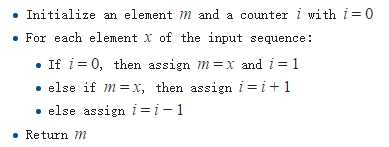标签:否则 com 进制 不能 vector targe algo org sort
Problem:
Given an array of size n, find the majority element. The majority element is the element that appears more than ? n/2 ? times.
You may assume that the array is non-empty and the majority element always exists in the array.
Summary:
求数组中出现频率大于数组一半的数,默认数组不为空且此数存在。
Analysis:
1. 将数组由小到大排序,由于所求之数出现次数大于n/2,故排序后位于n/2的数必为所求数。
1 class Solution { 2 public: 3 int majorityElement(vector<int>& nums) { 4 sort(nums.begin(), nums.end()); 5 int len = nums.size(); 6 7 return nums[len / 2]; 8 } 9 };
2. Hash表记录数组中出现数字与出现次数的映射。
1 class Solution { 2 public: 3 int majorityElement(vector<int>& nums) { 4 int len = nums.size(); 5 unordered_map<int, int> m; 6 7 for (int i = 0; i < len; i++) { 8 m[nums[i]]++; 9 } 10 11 unordered_map<int, int> :: iterator it; 12 for (it = m.begin(); it != m.end(); it++) { 13 if (it->second > len / 2) { 14 return it->first; 15 } 16 } 17 18 return -1; 19 } 20 };
3. 摩尔投票法(Moore majority vote algorithm)
(https://en.wikipedia.org/wiki/Boyer-Moore_majority_vote_algorithm)

此方法需要O(n)的时间和O(1)的空间。首先将第一个数字假设为所求之数,将计数器设置为1。遍历数组,比较数组中的数和假设之数是否相等,若相等则计数器加1,否则减1。当计数器为0时,将当前遍历到的数字设为新的假设之数,计数器初始化为1。如此重复,直至数组遍历结束,当前假设的数字极为所求之数。
1 class Solution { 2 public: 3 int majorityElement(vector<int>& nums) { 4 int len = nums.size(), res = nums[0], cnt = 1; 5 6 for (int i = 1; i < len; i++) { 7 if (res == nums[i]) { 8 cnt++; 9 } 10 else { 11 cnt--; 12 } 13 14 if (!cnt) { 15 res = nums[i]; 16 cnt = 1; 17 } 18 } 19 20 return res; 21 } 22 };
用此方法求解,若存在majority element则一定可以找到,若不存在也会返回一个结果,并不能判断是否存在有效值。
4. 位操作法(Bit Manipulation)
假设数组中所有数都是不超过32位的二进制数,那么对于每一位,计算数组中所有数在这一位上的值,若超过一半的数在这一位上值为1,则majority element在这一位上值为1,否则为0。
1 class Solution { 2 public: 3 int majorityElement(vector<int>& nums) { 4 int len = nums.size(); 5 int bits[32] = {0}, res = 0; 6 7 for (int i = 0; i < 32; i++) { 8 int cnt = 0; 9 for (int j = 0; j < len; j++) { 10 if ((nums[j] >> i) & 1) { 11 cnt++; 12 } 13 } 14 15 if (cnt > len / 2) { 16 res |= (1 << i); 17 } 18 } 19 20 return res; 21 } 22 };
标签:否则 com 进制 不能 vector targe algo org sort
原文地址:http://www.cnblogs.com/VickyWang/p/6010590.html